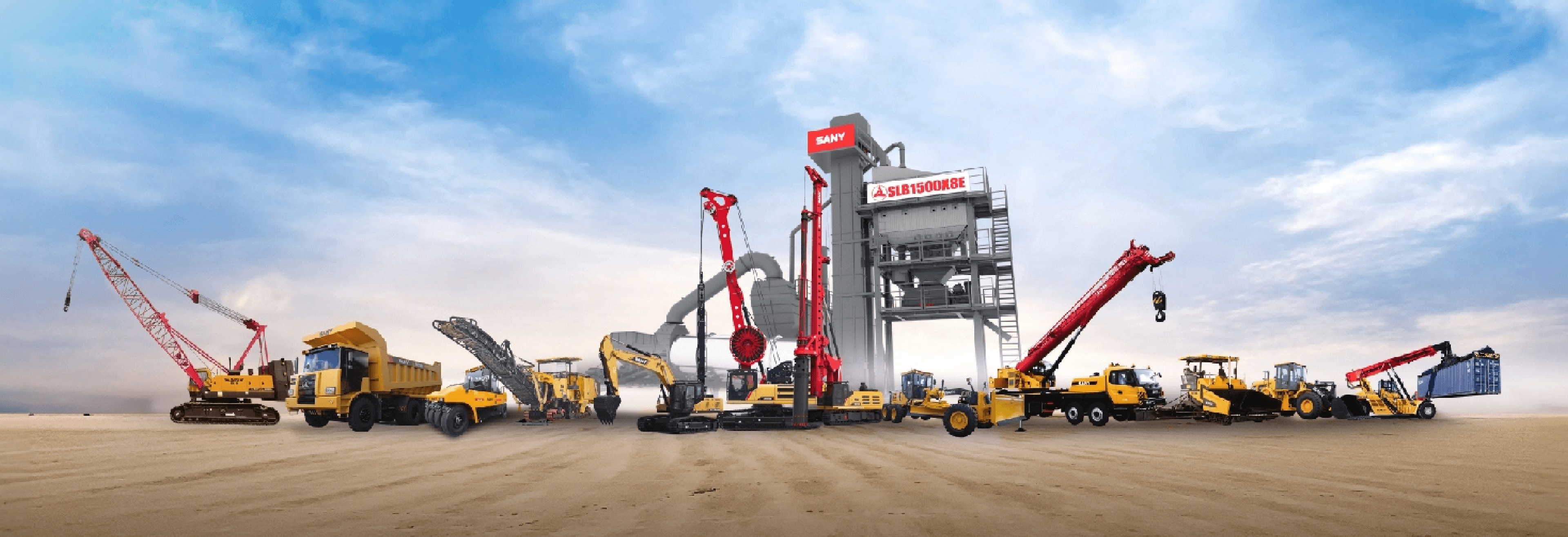LATEST Blog
Blog Categories:
All Blog:


The Future of Electric Forklift Battery Technology in India 2025: Powering Sustainable Material Handling
When forklifts sit idle, warehouses lose money. It's that simple. Warehouse managers and logistics leaders today face a challenging balancing act: maintaining smooth operations while controlling costs and meeting environmental objectives. Electric forklifts with lithium-ion batteries are becoming a game-changer here — they charge faster, run longer, and need less maintenance than traditional models. The numbers back up this trend. The electric forklift industry reached $85.1 billion in 2024, and experts project it will hit USD 132.7 billion by 2034, growing at a 4.6% annual rate. This growth reflects a global push toward cleaner, more efficient material handling—a movement that's gaining significant momentum across India's diverse logistics sector. Thinking about making the switch to electric forklifts? This guide walks you through the evolution of battery forklifts, tackling climate challenges specific to India, and showcasing innovative forklift solutions designed for maximum efficiency and sustainability. Evolution of Forklift Batteries: From Lead-Acid to Lithium-Ion Lead-acid batteries dominated electric forklifts in India for years, primarily due to their low initial cost. But these traditional systems come with significant limitations. They require up to 8 hours to charge, resulting in downtime while battery sets recharge. This means busy warehouses must invest in multiple battery sets, increasing costs and consuming valuable storage space. Reflecting this industry shift, lithium-ion batteries now hold a dominant 47.4% share in the forklift battery market, favored for their high energy density, longer lifecycle, and reduced maintenance compared to lead-acid alternatives. Lithium-ion technology has fundamentally improved the electric forklift market in India. These batteries charge rapidly and typically last about 10 years—far longer than lead-acid alternatives. With minimal downtime requirements, warehouses can maintain near-continuous operations. Addressing India's Diverse Climate Challenges India's climate varies dramatically across regions. Whether dealing with intense summer heat, coastal humidity, or northern cold storage facilities, forklift batteries face constant environmental stress. Lead-acid systems frequently struggle in these conditions—losing water more quickly in high temperatures, performing poorly in cold weather, and requiring intensive maintenance. Lithium-ion systems, equipped with thermal management and cooling technology, deliver consistent performance regardless of environmental conditions. This climate adaptability makes the current generation of forklifts, including SANY's models, particularly well-suited for Indian operations. SANY SCP30 and SCP50: Built for India’s Material Handling Needs While the advantages of lithium-ion technology are clear, SANY's approach stands out through engineering specifically designed for India's logistics and manufacturing requirements. The SANY SCP30, with a 3-ton capacity, is suited for…
read more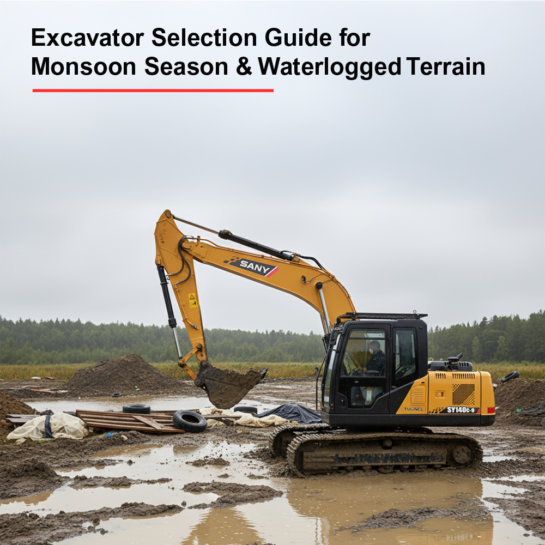

Excavator Selection Guide for Monsoon Season & Waterlogged Terrain
Heavy rainfall presents unique challenges for construction projects, including waterlogged terrain, reduced visibility, and potential equipment damage. Selecting the right excavator is crucial for maintaining productivity and ensuring operational safety during wet seasons. This guide examines the critical features to look for when choosing excavators specifically equipped to handle demanding rainy conditions. How to Choose the Right Excavator for the Rainy Season When selecting an excavator for rainy conditions, focus on these critical factors that determine performance in wet environments: Engine Power and Performance A powerful engine is essential for navigating through mud and waterlogged terrain. Look for excavators with robust engines that maintain consistent performance even when the ground becomes soft and unstable. Models with horsepower of ≥140 HP typically deliver reliable power and the necessary torque to overcome increased soil resistance. The engine's ability to maintain performance at varying RPMs is critical in challenging conditions. Weight Distribution and Stability Heavy rain softens the ground, making stability a primary concern. Heavy-duty excavators with substantial operating weights (20+ tons) offer exceptional stability on waterlogged surfaces. Pay attention to excavators with optimized weight distribution, as this minimizes the risk of tipping or sinking, allowing operators to work confidently even on rain-softened terrain. SANY offers wider undercarriage configurations, including track shoes up to 800mm wide, which help lower the ground bearing pressure and improve machine mobility in slurry or soft underfoot conditions. For example, the SANY SY140C-9 SALT model has an operating weight around 14,209 kg and features a reinforced undercarriage built with heavy-duty track chains and a robust swing ring body to enhance stability. Meanwhile, the medium-sized SANY210C-9 SPARC+ model balances stability and fuel efficiency, suitable for demanding terrain with a durable and resilient undercarriage design. Boom and Arm Configuration Extended reach capabilities reduce the need for repositioning on unstable ground. Excavators with longer booms (6 meters or more) allow operators to cover a larger area without needing to move the machine. Long-reach configurations are particularly valuable when working in areas near waterlogged sites, where machine repositioning could be hazardous. Consider models that offer versatility in arm attachments to adapt to various rainfall-related challenges. Hydraulic System Protection Rainy seasons create challenging conditions for hydraulic systems. When evaluating excavators, look for these protective features: Sealed hydraulic components that prevent water infiltration during heavy downpours High-quality filters that maintain hydraulic fluid integrity even in humid conditions Reinforced hydraulic lines protected against exposure to…
read more

How To Choose the Right Fuel-Efficient Excavator
With fuel expenses making up a large share of operating costs, selecting an excavator that optimizes fuel consumption is a strategic choice for construction companies. Environmental guidelines and the drive to improve sustainability further underscore the need for machines that excel in energy efficiency. SANY India’s latest excavators integrate intelligent hydraulics, superior power management, and robust construction, delivering both fuel savings and reliable output. Below is an overview of five SANY Excavators engineered to meet various heavy construction demands while prioritizing fuel economy and durability. 1. SANY SY390C-10HD GraMa: Heavy-Duty Efficiency Champion The 39-ton SANY SY390C-10HD GraMa is designed to excel in mining and quarry applications, particularly for granite and marble. It features intelligent hydraulic controls and regeneration systems to maximize digging power while minimizing fuel use. Key Fuel Efficiency Features: Dynamic Optimization Matching Control System (DOMCS) that adapts power to the workload Hydraulic energy recovery during operation reduces fuel wastage The Power Boost system enhances digging force efficiently Ideal for demanding quarry environments, it strikes a balance between high productivity and fuel-conscious operation. 2. SANY SY80C-9 PRO: Versatile Small Excavator Designed for medium-duty urban and quarry tasks, the 7.9-ton SANY SY80C-9 PRO uses load-sensing hydraulics and multiple work modes, including an eco setting to optimize fuel consumption. Key Fuel Efficiency Features: Load-sensing hydraulic system adjusts flow to task needs Eco and power modes for flexible fuel management Long hydraulic oil intervals reduce downtime Its compact design, combined with efficient hydraulics, offers versatile performance that saves on fuel and maintenance costs. 3. SANY SY35U PRO: Compact Urban Efficiency Specialist The 3.7-3.9 ton SANY SY35U PRO excels in urban construction and landscaping, featuring a zero-tail-swing design with minimum tail swing and advanced load-sensing hydraulics for fuel-efficient operation in confined spaces. Key Fuel Efficiency Features: Precise hydraulic oil flow control for energy savings Reduced unnecessary movements due to compact design Extended hydraulic service intervals This model provides reliable precision digging with enhanced fuel economy in space-restricted environments. 4. SANY SY225C-10HD GENe+: Energy-Efficient Mid-Range Specialist With an operating weight of 22.5 ton, the SANY SY225C-10HD GENe+ combines robust performance with fuel-saving technologies, such as direct power control and hydraulic flow regeneration, tailored for demanding construction projects. Key Fuel Efficiency Features: Hydraulic power recovery systems Multiple optimized working modes for fuel management Software-driven engine tuning for efficient performance This excavator is designed to deliver power efficiently, reducing fuel consumption without compromising productivity. 5. SANY…
read more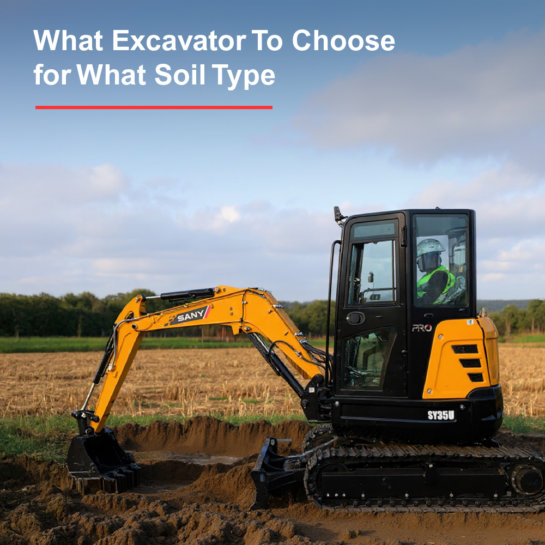

What Excavator To Choose for What Soil Type
Ever stood at a construction site, looking at different soil compositions and wondered, "What excavator do I actually need for this?" You're not alone! Choosing the right excavator for your specific soil conditions can make the difference between a smooth-running project and one plagued with inefficiencies. Whether you're dealing with sticky clay that clings to everything or loose sand that won't stay put, the right machine can turn these challenges into just another day at work. Let's dig into what you need to know about matching excavators to soil types. Understanding Soil Types and Their Challenges Before you even think about equipment selection, you need to understand what you're working with. Different soils present unique excavation challenges: Clay Soil: Dense and sticky when wet, hard and compact when dry. Clay can cling to equipment, requiring more power to move and additional maintenance to keep buckets clean. Sandy Soil: Loose and unstable, prone to cave-ins. Sandy soil requires machines with good stability and possibly wider tracks to prevent sinking. Rocky Terrain: Requires higher power and specialized attachments. The impact of hitting rocks can strain equipment not designed for such conditions. Loamy Soil: Mixed composition with good workability. Generally the easiest to excavate but may still present challenges if moisture content varies. Wet/Marshy Areas: Presents stability and mobility challenges. Standard excavators may sink or get stuck in these conditions. Mini Excavators for Light to Medium Soils When you're working with loamy or sandy soils in confined spaces, compact mini excavators provide excellent maneuverability. Machines in the 2-4 ton range work effectively in light soils where space constraints are a concern. For residential work, landscaping, or utility installation in these soil types, mini excavators strike the perfect balance between power and agility. The key specs to look for in these conditions include: Operating weight of 1.5-4 tons Boom length of 1.8-2.5 meters Engine power of 15-30 hp Take the SANY SY35 Pro, for example. With its operating weight of 3.7-3.9 tons, 28HP engine, and improved load-sensing hydraulic system, it delivers exceptional performance in sandy and loamy soils. Its 300mm wider track shoes offer excellent traction in loose terrains, such as sand and slurry, reducing ground pressure while improving stability. The SY35 Pro's 0.12m³ wider profile bucket is particularly effective for efficient material handling in softer soils, reducing the number of operational cycles needed to move material. Small Excavators for Mixed Soil Conditions When…
read more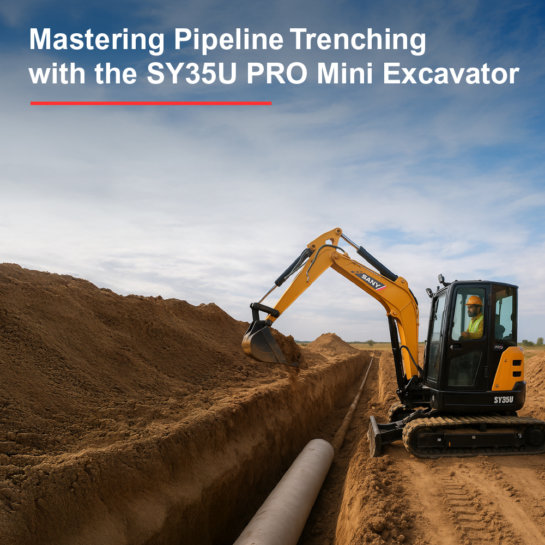
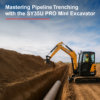
Mastering Pipeline Trenching with the SY35U PRO Mini Excavator
The Pipeline Trenching Challenge Pipeline installation projects often present contractors with a frustrating dilemma: how to create precise, narrow trenches in confined spaces without causing excessive disruption to the surrounding area. Traditional large excavators can be too cumbersome for tight urban environments, while manual trenching is painfully slow and labour-intensive. The result? Project delays, increased costs, and unnecessary surface damage that requires extensive restoration work. For contractors working in India's diverse terrain and increasingly dense urban areas, finding the right balance between power, precision, and manoeuvrability has become essential for successful pipeline projects. This is where specialized trenching equipment like mini excavators becomes invaluable. Why Precision Matters in Pipeline Trenching Precision isn't just about aesthetics—it's about project viability and cost efficiency. When installing water, gas, or telecommunications pipelines, even small deviations in trench depth or width can lead to significant problems: Inconsistent trench depth affects proper pipe gradient, potentially causing flow issues Excessive excavation means more backfill material and increased restoration costs Uneven trench walls can compromise pipe bedding and support Wider-than-necessary trenches increase surface disruption in urban areas The SY35U PRO mini excavator in India addresses these challenges with its minimum tail swing/zero tail swing design and compact dimensions (4,910 mm length, 1,550 mm width,2545 mm height). Its design further enhances easy and economic transportability, including the ability to self-load onto trucks using its narrow-width track assembly — saving time and cost during project shifts. Features that Make Mini Excavators Ideal for Trenching Small mini excavators like the SY35U PRO offer several advantages over larger machines when it comes to pipeline trenching: Compact Design with Minimum Tail Swing/Zero Tail Swing: The SY35U PRO can rotate at the base while remaining within the width of its tracks, allowing work near walls, foundations, and other obstacles. Powerful Despite Size: With 28HP of engine power, this mini digger in India has the strength needed for efficient trenching. Superior Hydraulic Control: The load-sensing hydraulic system, featuring variable displacement pumps, provides precise control for creating clean, accurate trenches. Boom Swing Capability: This feature enables offset digging alongside obstacles without repositioning the machine, which is crucial for pipeline work along existing structures. Minimal Ground Pressure: At just 32kPa, the SY35U PRO minimizes damage to surrounding surfaces, critical when working on finished surfaces or sensitive areas. 5 Best Practices for Deep and Narrow Trenches Creating effective pipeline trenches with a mini excavator requires skill and technique.…
read more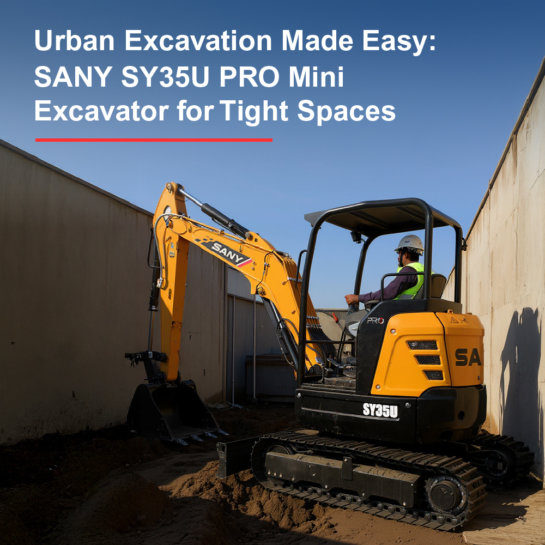
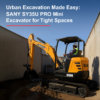
Urban Excavation Made Easy: SANY SY35U PRO Mini Excavator for Tight Spaces
Urban Construction Challenges: How Tight Spaces Increase Project Costs Urban construction in India often involves working within tight spaces. For instance, in Mumbai's dense Andheri and Bandra-Kurla Complex areas, construction teams regularly encounter sites with barely 2-3 meters of clearance between existing structures. Working in Bangalore's IT corridor, specifically in Whitefield and Electronic City, creates narrow working zones that are often filled with underground utilities. Chennai's congested areas like T. Nagar's commercial lanes and the narrow bylanes of Mylapore, present equally challenging scenarios. When equipment can’t fit, it leads to costly rerouting, extra overtime, and skilled workers waiting around—all of which cause project delays and eat into budgets. These hidden costs of lost time, additional labor, and setbacks can quietly add up and affect even the best-planned projects.. The lesson is clear: in urban excavation, the right machine isn’t a luxury, it’s a necessity. Why Mini Excavators Are Essential For Urban Jobsites In today’s urban landscape, small doesn’t mean second-best. It means surgical precision. The SANY SY35U PRO Mini Excavator is designed to tackle exactly these challenges. With zero tail swing /minimum tail swing and a compact 1.55 M/1.72M width, it slips through narrow alleys and works right up against buildings—no need for constant repositioning or risky manoeuvres. Real-world contractors report up to 15% time saved on alleyway digs simply by using equipment that fits the space and the job. Operator Comfort and Control: Boosting Productivity in Urban Excavation But urban jobs aren’t just about size. Long days in cramped quarters can wear down even the best operator. The SY35U PRO is designed for comfort and control. The multi-adjustable, waterproof suspension seat withstands Mumbai’s heavy rains, keeping operators dry and focused. It's effortless, thumb-controlled joysticks reduce fatigue, while the cabin is quiet, calm, and equipped with modern touches like a USB music system, 12V socket, and an informative colour display. Real-Time Telematics: Optimize Fleet Management and Reduce Downtime What really sets the SY35U PRO apart is its EVI telematics system. Real-time dashboards display your machine’s location, performance, and indicate when it requires maintenance. This means you never under- or over-deploy your SY35U PRO, keeping your fleet efficient and your projects on track. Maintenance alerts and remote monitoring reduce downtime and help you make data-driven decisions—no more flying blind. Urban Excavation Safety Features: 360° Visibility and Operator Protection The SY35U PRO’s ROPS & TOPS-certified cabin, robust steel side panels, and boom light…
read more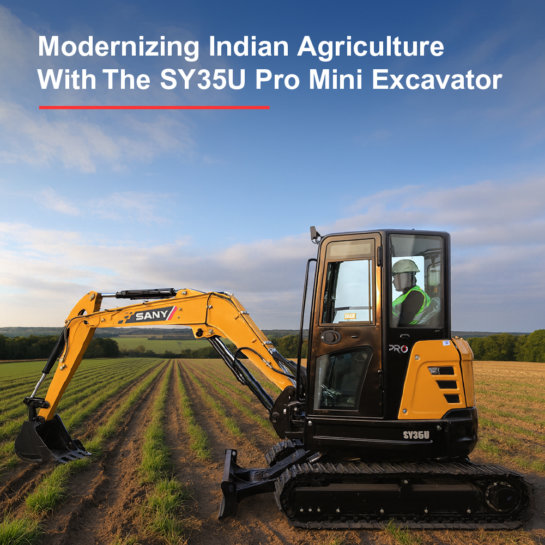
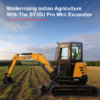
Modernizing Indian Agriculture With The SY35U PRO Mini Excavator
Agriculture is rapidly evolving, with farmers increasingly turning to compact machinery to enhance productivity and efficiency. Mini excavators, once primarily associated with construction sites, are now becoming essential tools on farms across India. These versatile machines are transforming how farmers approach infrastructure development, land management, and daily operations, offering solutions to challenges that previously required extensive manual labor or multiple specialized equipment. Mini Excavators for Farm Infrastructure Work Farm infrastructure development and maintenance are critical aspects of agricultural operations that directly impact productivity. Mini excavators excel in these applications thanks to their exceptional versatility and performance characteristics. With a compact width of just 1.55m/1.72m, mini excavators like the SY35U PRO can navigate through narrow farm pathways and access restricted areas that would be impossible for larger machinery. The machine's zero-tail-swing (also available in minimum tail swing) design allows it to work very close to existing structures without repositioning, making it ideal for infrastructure projects around barns, storage facilities, and other farm buildings. These versatile machines are invaluable for developing water management systems, constructing animal shelters, building access roads, and establishing proper drainage - all crucial elements of successful farming operations. Top Tasks: Trenching, Digging, Loading When it comes to essential agricultural operations, mini excavators in India excel in three critical areas, each particularly valuable in specific regions: Trenching: Proper irrigation and drainage are vital for crop health and land management. Mini diggers feature impressive bucket digging force, making them highly efficient at creating trenches for irrigation lines, drainage systems, and utility installations. Their precise controls enable accurate depth and width adjustments, ensuring trenches meet the exact specifications required for agricultural applications, especially crucial in extensive paddy fields and irrigation-dependent dry zones. Digging: From creating ponds and water reservoirs to preparing land for planting, digging operations are streamlined with mini excavators for agriculture. With substantial digging depth capabilities and strong-arm force, these machines can handle considerable excavation projects while maintaining stability, even in compacted soil conditions and mixed crop farms. Loading: Material handling becomes more efficient with the mini excavator's bucket capacity and swing speed. This combination reduces cycle time during material shifting operations, whether loading compost, moving feed materials, or clearing agricultural debris. The impressive dumping height allows for efficient loading into farm trucks and other containers, benefiting farms across India’s plantations and agricultural zones. Top Essential Attachments for Agricultural Use The versatility of mini excavators extends through their compatibility with…
read more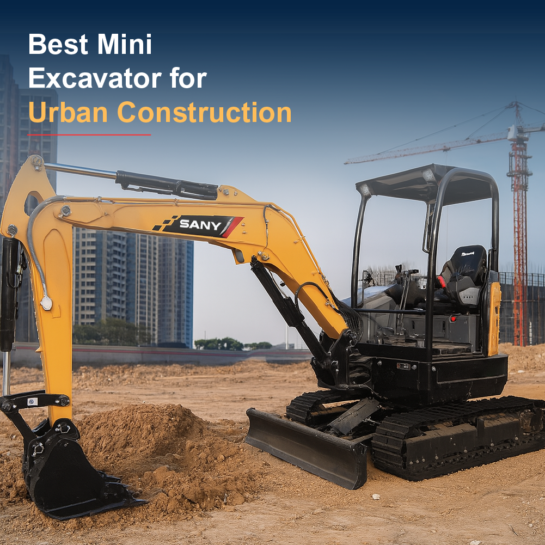
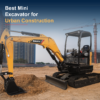
Best Mini Excavator for Urban Construction
Urban construction projects present unique challenges that require specialized equipment. Confined spaces, noise restrictions, and environmental considerations all demand machines that are compact yet powerful. When selecting equipment for urban construction, several key factors must be considered, including size limitations, noise output, emissions, and versatility. The right equipment can make the difference between project success and costly delays in these challenging settings. Sany's line of mini excavators provides the ideal solution for construction professionals operating in urban environments. Let's explore the best options from Sany's catalogue and the key factors to consider when selecting the right mini excavator for your urban construction needs. How to Choose the Right Excavator for Urban Construction Construction professionals working in urban environments must carefully select equipment that balances power with maneuverability. Mini excavators, compact loaders, and other space-efficient machinery have become essential tools for city projects, allowing crews to work effectively even in tight quarters. 1. Size and Maneuverability In urban construction, space constraints often determine equipment selection. Sany's mini excavators feature zero tail swing designs that allow operation in tight spaces without sacrificing performance. The SY20U and SY27U are particularly effective for navigating between existing structures, working in alleyways, or operating in partially completed buildings. 2. Noise Levels and Environmental Considerations Urban construction sites frequently face strict noise ordinances. Sany's mini excavators incorporate advanced sound dampening technology and efficient engines that reduce operational noise—a critical factor when working near residential areas or during restricted hours in city centers. 3. Fuel Efficiency and Operating Costs With rising fuel costs and environmental concerns, efficiency is paramount. Sany's mini excavators feature optimized hydraulic systems and fuel-efficient engines that maximize productivity while minimizing fuel consumption. The precision-engineered components ensure less downtime and lower maintenance costs over the equipment's lifecycle. 4. Versatility and Attachments Urban projects often require multiple functions from a single machine. Sany's excavators are equipped with various attachments that transform these machines into versatile tools capable of handling diverse tasks—from breaking concrete to precision grading—without requiring additional equipment in crowded urban sites. Right Excavator for Urban Projects Urban environments demand construction equipment that can navigate tight spaces without sacrificing performance. Sany's mini excavator lineup is specifically designed to meet these challenges, offering compact machines that deliver exceptional power and precision. SY20U: Unmatched Accessibility for Extremely Limited Spaces Weighing just 1.98 tons, the SY20U is Sany's most compact offering, making it ideal for projects in extremely…
read more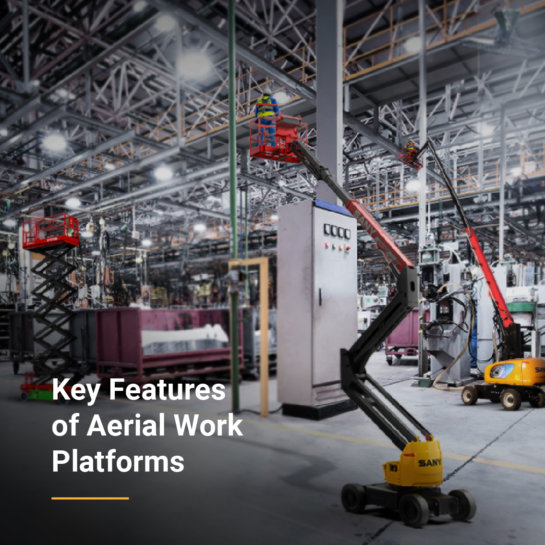

Key Features of Aerial Work Platforms
Working at heights doesn’t have to be a balancing act. Whether you’re navigating a construction site, repairing hard-to-reach areas, or organising a busy warehouse, Aerial Work Platforms (AWPs) are the ultimate game-changer. These innovative machines combine safety and efficiency, making elevated tasks not only easier but also far less risky. In this blog, we’ll explore the key features of AWPs and explain how these versatile machines make working at heights safer, more efficient, and adaptable to various environments. What Are Aerial Work Platforms (AWPs)? Aerial Work Platform (AWP) is a machine designed to lift workers and equipment safely to high places. Also known as aerial work platforms, they are commonly used in industries like: Construction Maintenance Warehousing Utilities Airports Cement Plants Steel Plant Metro Bridges AWPs are used to make tasks at heights, like repairs, installations, or inspections, much easier and safer than traditional methods like ladders or scaffolding. They come in different designs to meet various needs, depending on the job. Types of Aerial Work Platforms Scissor Lifts How they work: A scissor mechanism lifts the platform straight up. Ideal for: Jobs that require a stable, spacious platform at heights, such as electrical work, painting, or warehouse stock picking. Best for: Applications where you need a large working area, such as facility maintenance and construction sites. Lifting capacity: 500–1500 kg Telescopic Boom Lifts How they work: The boom extends straight out to great heights, giving you access to tough-to-reach places. Ideal for: Jobs that need high, straight access with minimal horizontal movement. Best for Outdoor tasks, such as building maintenance, construction work, or any job requiring a direct and high vertical reach. Lifting capacity: 230–450 kg Articulating Boom Lifts How they work: These lifts have joints that allow the platform to move over and around obstacles, providing more flexibility. Ideal for: Jobs that require precise movement and access around obstacles. Best for: Applications like power line maintenance, airports, Metro bridges, industrial applications or jobs requiring flexibility over and around barriers. Lifting capacity: 200–350 kg Key Features of Aerial Work Platforms Designed to simplify challenging tasks at heights, AWPs come equipped with cutting-edge features that prioritize both safety and functionality. Superior Lifting Capacities AWPs come in various lifting capacities to carry more weight, including workers, tools, and heavy equipment. For example, scissor lifts can handle heavier loads, making them great for carrying equipment, while boom lifts provide the necessary reach…
read more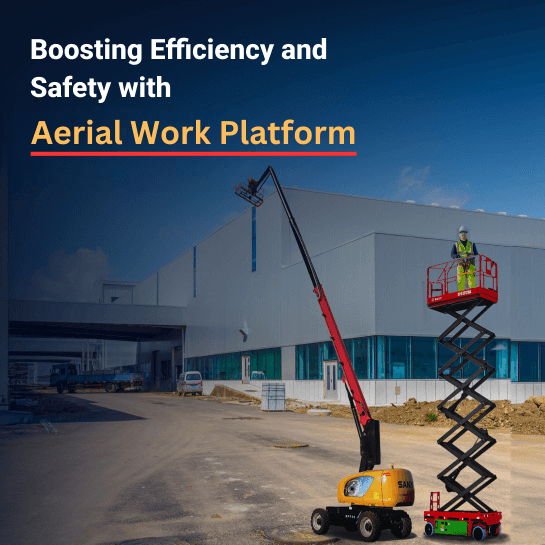
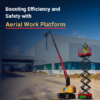
Boosting Efficiency and Safety with aerial work platforms
Elevated workspaces often bring challenges such as inefficiency, safety risks, and high costs when relying on traditional tools like ladders and scaffolding. These limitations can slow down progress and increase operational hazards. AWPs address these issues with solutions that enhance efficiency, improve safety, and reduce operational costs. In this blog, we will explore how Aerial Work Platform are transforming industries and optimising operations. Understanding Aerial Work Platforms An Aerial Work Platform (AWP) is a mechanical device designed to provide temporary access to high or hard-to-reach areas. AWPs come in various forms, each tailored to specific applications: Scissor Lifts: Known for their vertical lifting mechanism, scissor lifts are ideal for tasks that require workers to move straight up and down. They are often used in warehouses, maintenance tasks, and installations where stability is paramount. Articulating Boom Lifts: These lifts have jointed arms that allow vertical as well as horizontal reach, making them perfect for navigating obstacles in confined spaces. Common applications include construction sites and utility maintenance. Telescopic Boom Lifts: Also called straight booms, these boom lifts extend in a straight line, providing maximum reach and height. They are typically used in high-rise construction projects, building maintenance, and heavy equipment servicing. AWP Benefits Aerial Work Platform are redefining how industries operate in elevated workspaces. These innovative tools offer a range of advantages that are game-changing. 1. Efficiency at Its Best Aerial Work Platform are designed to optimise productivity by enabling workers to access elevated areas quickly and safely. Unlike traditional ladders or scaffolding, which require extensive time for setup and repositioning, Aerial Work Platform can be deployed with ease and adjusted swiftly during operations. Their superior manoeuvrability ensures that workers can focus on their tasks rather than wasting time navigating large and heavy equipment. For example, articulating boom lifts allow operators to reach areas around obstacles, while scissor lifts are perfect for vertical tasks in confined spaces like warehouses. By incorporating Aerial Work Platform, businesses can achieve more in less time, leading to faster project completions and cost savings. 2. Enhancing Worker Safety Safety is a cornerstone of any industrial operation, especially when working at heights. Aerial Work Platform provide a secure and stable platform for workers, equipped with features such as: Guardrails to prevent falls. Fall protection systems to secure workers in place. Stable platforms that reduce the risk of instability. Overload protection Angle sensor These features minimise workplace injuries and ensure…
read more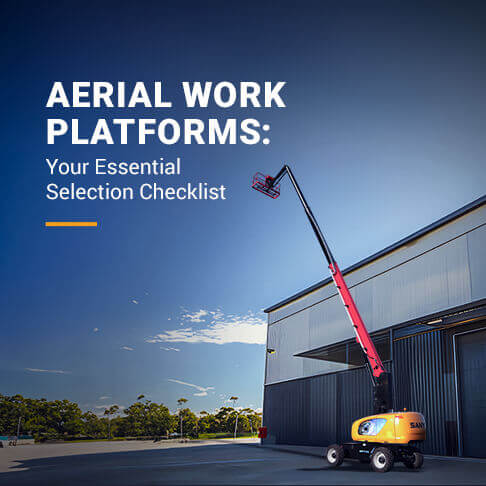
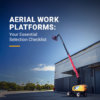
Aerial Work Platforms: Your Essential Selection Checklist
Are you looking for a reliable machine to safely lift workers to perform tasks like repairing overhead electrical wires? For these types of jobs, you require a specialized solution—Aerial Work Platforms. Whether it's for construction, maintenance, or repairs, Aerial Work Platforms (AWPs) are essential tools to ensure safety, increase productivity, and handle tasks at various heights. But with so many options available, how do you know which AWP is the right fit for your project? Let’s dive into this comprehensive guide to help you choose the perfect Aerial Work Platform. What is an Aerial Work Platform? An Aerial Work Platform (AWP) also known as an Elevated Work Platform (EWP) is a mechanical device used to provide temporary access to workers at elevated heights. These platforms are typically equipped with safety features such as guardrails and fall protection systems, allowing workers to safely perform tasks in elevated positions. AWPs are widely used in industries such as construction, maintenance, and warehousing. What are the Major Types of Aerial Work Platforms and Their Applications? When it comes to aerial work platforms, selecting the right one depends on the type of task and the work environment. Below are the major types of aerial lift platforms and their common applications: Telescopic Lifts: Telescopic lifts, also known as straight or stick booms, are perfect for tasks that require extended reach at a fixed height. These are ideal for jobs like tree trimming, construction, and steelwork installations, where a worker needs to access hard-to-reach areas. Boom Lifts: Boom lifts provide more flexibility than telescopic lifts, with extendable arms that can move horizontally and vertically. They are best suited for jobs that require versatile movement, such as electrical maintenance or window cleaning at varying heights and angles. Spider Lifts: Known for their lightweight design and compact structure, spider lifts are perfect for navigating narrow and confined spaces. These lifts are often used in tasks requiring access to difficult areas such as indoor maintenance or confined outdoor spaces. Scissor Lifts: Scissor lifts offer a stable, vertical lifting motion. With a large platform, they are ideal for jobs requiring access to large surface areas at heights, such as painting, roofing, or ceiling installations. Vertical Personnel Lifts: These lifts are lightweight and designed for one person. They are used primarily for indoor jobs like changing light bulbs or performing repairs in warehouses or offices. Articulated Lifts Also known as knuckle booms,…
read more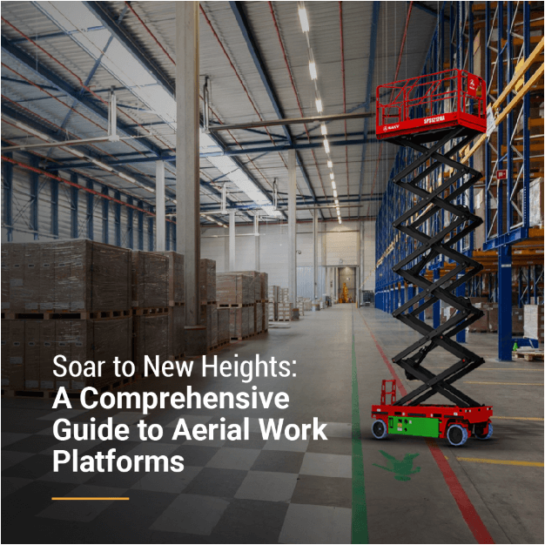

Soar To New Heights: A Comprehensive Guide To Aerial Work Platforms
In the ever-evolving landscape of construction, maintenance, and industrial operations, Aerial Work Platforms (AWPs) play a crucial role in reaching new heights—literally and figuratively. This comprehensive guide delves into the various types of AWPs, their essential safety features, and best practices for maintenance and inspection. Whether you are an industry professional, facility manager, or simply interested in the mechanics of high-access equipment, this guide will provide valuable insights into selecting, operating, and maintaining AWPs to ensure safety, efficiency, and optimal performance. What is an Aerial Work Platform (AWP)? An Aerial Work Platform (AWP) is a mechanical device designed to provide elevated access for personnel and equipment to perform tasks at height. Commonly referred to as aerial lifts, these platforms include various types such as scissor lifts, boom lifts, and personnel lifts. They are equipped with a platform or basket supported by hydraulic, pneumatic, or mechanical systems that allow for vertical and horizontal movement. AWPs are utilized in construction, maintenance, and industrial applications to enhance safety and efficiency when working at elevated positions, adhering to strict safety standards and operational guidelines. Types of Aerial Work Platforms Aerial Work Platforms come in various options, offering easy accessibility for different use cases. Some are optimized for indoor or outdoor use, some for people or equipment, and some for flat or rough surfaces. Here are some of the most common types of Aerial Work Platforms. Scissor Lifts Scissor lifts have a platform that rises vertically using a crisscrossing mechanism of linked, folding supports. They offer stable, high-reaching access for tasks requiring substantial horizontal workspace and are ideal for indoor use or flat surfaces. Boom Lifts Boom lifts feature a platform mounted on an extendable arm or boom, which allows both vertical and horizontal reach. They come in two main types: telescoping (straight) and articulating (knuckle) booms, providing flexibility for accessing hard-to-reach areas. Vertical Mast Lifts These compact lifts have a narrow base and a vertical mast that extends upwards, offering access to high places in tight spaces. They are suitable for indoor applications and are often used for maintenance tasks. Personal Lift Platforms Designed for individual use, these lifts are typically smaller and more portable. They provide access to elevated areas with limited space and are used for tasks like shelving, lighting maintenance, and other small-scale applications. Trailer-Mounted Lifts Also known as tow-behind lifts, these are mounted on a trailer and can be towed…
read more
